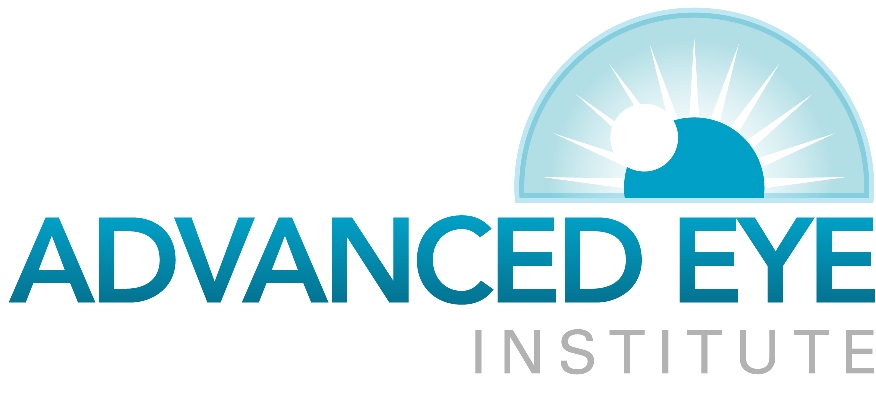Lens Replacement Options
WHAT ARE INTRAOCULAR LENSES (IOLS)
During cataract surgery your clouded natural lens will be replaced with what is known as an “Intraocular lens” or IOL. This is an artificial lens implant commonly made of silicone, acrylic or other types of plastic compositions that will serve to focus incoming light rays onto the retina .This implant is made to be implanted and will last for the rest of your life though it can be removed or replaced sometimes if found to be medically necessary. You will require an implant during your surgery otherwise you would require too heavy of a glasses prescription or contact lens prescription following the removal of the body’s natural clouded lens.
What many patients do not realize is there are a variety of lens replacement options you may choose from and all have different benefits and visual consequences. Not all IOLs are covered by insurance, but most insurance providers will cover the cost of a traditional “Monofocal” IOL.
IOLs come in different focusing powers just like a glasses or contact lens prescription. You need to measure the length of the eye and curvature of the cornea in order to be able to accurately predict the IOL power that will be needed to focus the eye at its intended target range. This makes IOL measurements a critical step in minimizing glasses prescriptions after cataract surgery. Issues such as dry eye and corneal irregularities from previous refractive eye surgeries can greatly effect the accuracy of IOL measurements.
When discussing IOL replacement options it is important to understand that there are essentially 3 functional ranges of vision humans use in daily activities. These are distance, intermediate, and near ranges. Describing these ranges can be different for everyone, but in general, distance range gives us our sharp driving or TV viewing vision for example. Intermediate range would be the range we view a computer or smart tablet. Near range is where reading a book, magazine or often cell phone viewing occurs. Placing the appropriate power and/or type of IOL can aid patients in seeing these ranges independent of glasses correction and is a major focus in modern day cataract surgery.
What Are My Lens Replacement Options?
Monofocal IOL
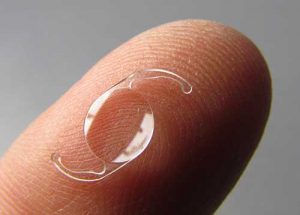 These are the most common lenses implanted during cataract surgery. Mono means one, so these lenses only have one focusing distance. You can choose to set the range at distance, intermediate, or near but the other ranges that are not specifically targeted are not able to be seen without the aid of glasses or contact lenses in a given eye. Most people choose to set their range at distance since many patients use vision at this range most often. Patients will then where glasses for intermediate and near ranges as necessary.
These are the most common lenses implanted during cataract surgery. Mono means one, so these lenses only have one focusing distance. You can choose to set the range at distance, intermediate, or near but the other ranges that are not specifically targeted are not able to be seen without the aid of glasses or contact lenses in a given eye. Most people choose to set their range at distance since many patients use vision at this range most often. Patients will then where glasses for intermediate and near ranges as necessary.
Of note, these lenses DO NOT CORRECT ASTIGMATISM, therefore if astigmatism is present in the cornea, these lenses will not address this issue. Regular astigmatism can be corrected with glasses, contact lenses, Toric IOLs, or surgically with incisions.
Monofocal lenses can also be used to set patients with “Monovision” which means the dominate eye is set at a distance range and the non-dominant eye is set at an intermediate or near range depending on patient preference. This is one way to minimize the need for prescription glasses for both distance and near ranges, however, it can be hard to get used to for many patients, and can cause trouble with high precision depth perception (ie threading fishing line through a hook) . At Advanced Eye Institute we find ideal patients are those who have previously tolerated it well in contact lenses prior to cataract procedure.
All in all, Monofocal lenses provide for an excellent lens replacement option as they perform well in all lighting conditions, do not sacrifice contrast (ok for severe glaucoma and macular degeneration patients) , and are not associated with glare/halos. Their major limitations are that they are only able to set the eye to be in focus at one range and they do not correct astigmatism.
Advanced Technology Intraocular Lenses (ATIOLs) aka Premium IOLs
The terms “ATIOL” and “premium” IOL are often used when referring to several types of lenses that are not traditionally covered by most insurance providers but can provide “refractive” or prescription minimizing benefits to patients undergoing cataract surgery. Cataract surgery is a time where the surgeon will already be inside the eye correcting the medical problem of the cataract. Patients can choose to have a combined refractive procedure that can be preformed by using one of the ATIOLs in an effort to minimize refractive error (glasses prescription) in the eye after surgery, and accomplish visual outcomes based on individual visual goals. The ATIOLs offered at Advanced Eye Institute include Toric monofocal IOLs, Multifocal IOLs, Extended Depth of Focus (EDOF) IOLs, Trifocal IOLs, Toric Multifocal/EDOF/Triofocal IOLs.
Toric Monofocal IOLs
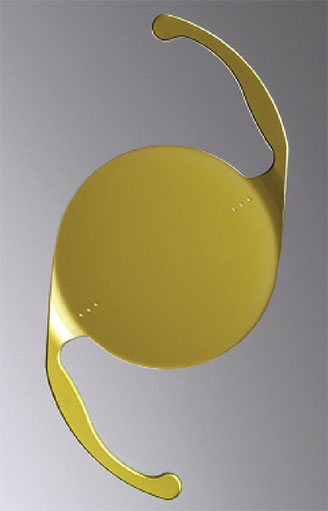 Astigmatism can come from both the cornea and the body’s natural lens, but since the natural lens is being removed with cataract surgery we only have to account for the astigmatism that is found in the cornea when measuring patients for cataract surgery. Corneal astigmatism is caused when the curvature of the cornea is not uniform. If the cornea is shaped like a sphere (front of a basketball), there is no astigmatism. If the curvature is not uniform in two planes (front of a football), astigmatism will cause blurring of the vision. Special lenses called cylinders must be used to neutralize the astigmatism and give clear vision. This is what is done in glasses to correct astigmatism. The cylinder is used to counteract the astigmatism at the irregular plane. This type of correction can be referred to as “Toric” correction when found in contact lenses or IOLs.
Astigmatism can come from both the cornea and the body’s natural lens, but since the natural lens is being removed with cataract surgery we only have to account for the astigmatism that is found in the cornea when measuring patients for cataract surgery. Corneal astigmatism is caused when the curvature of the cornea is not uniform. If the cornea is shaped like a sphere (front of a basketball), there is no astigmatism. If the curvature is not uniform in two planes (front of a football), astigmatism will cause blurring of the vision. Special lenses called cylinders must be used to neutralize the astigmatism and give clear vision. This is what is done in glasses to correct astigmatism. The cylinder is used to counteract the astigmatism at the irregular plane. This type of correction can be referred to as “Toric” correction when found in contact lenses or IOLs.
Toric monofocal IOLs offer a way to correct moderate to severe corneal astigmatism (over 1.25 diopters) at the time of cataract surgery, and they offer the same quality vision monofocal lenses provide without any contrast deficiencies or halos around headlights. They also have one similar limitation in that they are only able to set the eye to be in focus at one range. Patients often will choose to be in focus at distance and plan to where over the counter readers for near and intermediate ranges. Toric monofocal IOLs are acceptable to use for monovision in patients who want this type of correction but who have moderate to severe astigmatism.
Toric monofocal lenses are not covered by most insurance providers. In addition there are also special measurements and testing required to make sure you are an appropriate candidate for a Toric monofocal IOL that may not be covered by your insurance as well. These lenses are acceptable lens replacement options for patients with diseases that lower contrast sensitivity such as macular degeneration and severe glaucoma but a conversation with your surgeon is necessary to make sure you will get the appropriate benefit from implantation of this type of IOL.
Toric lenses must be positioned very precisely in the correct meridian degree to correct astigmatism appropriately which does add some complexity to the IOL placement. If the lens is not placed on the correct meridian degree or it rotates in the few days after implantation it may need to be repositioned by the surgeon. At Advanced Eye Institute, when placing these IOLs we prefer Laser cataract surgery to assist us in the centration of these lenses so they are well centered in the eye, and the ORA system helps in making sure the astigmatism is adequately neutralized before leaving the operating suite.
Of note, there are corneal irregularities such as corneal scarring, previous refractive surgery with Radial Keratotomy , or decentered LASIK ablations that could result in what is known as “Irregular” Astigmatism. This type of astigmatism is not able to be well corrected in traditional glasses or contact lenses and this is also true of Toric IOLs. These patients often get the best quality vision from rigid gas permeable hard contact lenses such as RGPs.
Multifocal IOLs
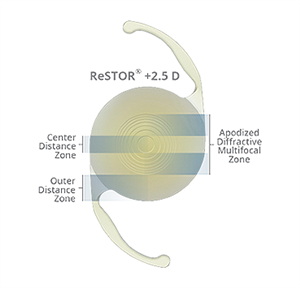 Multifocal IOLs are modern medicine’s best attempt to solve the issue of “presbyopia” or inability to focus on objects clearly at both distance and near ranges. Presbyopia is caused when the body’s natural lens is no longer able to change its shape to in order to bring in extra focusing power to see images at near or close range. This is why patients with perfect distance will often be dependent on over the counter reading glasses sometime between their forties and fifties. It is also the reason for needing bifocals in prescription glasses. The eye’s natural lens was once able to accomplish this by changing shape with muscles inside the eye when focusing at different ranges, a process known as “Accomodation”. IOLs that tried to copy this type of change in shape to enhance near focusing power were not able to deliver high acuity near range vision. These IOLs were known as “Accommodative” IOLs. With the advent of better multifocal IOL technologies these IOLs have largely been replaced by the modern day binocular Multifocal IOLs.
Multifocal IOLs are modern medicine’s best attempt to solve the issue of “presbyopia” or inability to focus on objects clearly at both distance and near ranges. Presbyopia is caused when the body’s natural lens is no longer able to change its shape to in order to bring in extra focusing power to see images at near or close range. This is why patients with perfect distance will often be dependent on over the counter reading glasses sometime between their forties and fifties. It is also the reason for needing bifocals in prescription glasses. The eye’s natural lens was once able to accomplish this by changing shape with muscles inside the eye when focusing at different ranges, a process known as “Accomodation”. IOLs that tried to copy this type of change in shape to enhance near focusing power were not able to deliver high acuity near range vision. These IOLs were known as “Accommodative” IOLs. With the advent of better multifocal IOL technologies these IOLs have largely been replaced by the modern day binocular Multifocal IOLs.
Multifocal IOLs attempt to provide simultaneous distance and near vision without the aid of glasses and accomplish this through the optical principle of diffraction. Since there are essentially two focal points created inside the eye by manipulating the light in this way there can be some visual consequences. Though these adverse visual phenomenon do not occur in all patients they are possible with implantation of multifocal IOLs. Reported side effects of multifocal IOLs are:
- Glare and halos from car headlights or other single points of light
- Loss of contrast sensitivity (especially in low lighting conditions)
- Still need glasses correction for some activities
All in all, the benefit of multifocal lenses are that they can provide patients a means to be independent of glasses for most activities by offering a way to see at both distance and near ranges. In the past, intermediate vision was often found lacking with the older multifocal IOL technologies, but now that multifocal IOLs are available in a variety of near focal point add powers the surgeon can use different add powers between the two eyes to offer more range of vision.
The limitations of these IOLs are that they can decrease contrast and provide for some glare and halos with nighttime driving. Also, there can be a period of “neuroadaptation” where the brain must adapt to the dual images it receives from the multifocal IOL so it may take some time for patients to get accustomed to the new lens. These IOLs also work best when implanted in both eyes, and mixing technology with monofocal IOLs may result in underperformance of the multifocal IOL especially at near ranges.
These lenses are not covered by most insurance providers and require special testing and measurements that may also not be covered. Also, it should be noted that these lenses are NOT acceptable lens replacement options for patients with diseases that lower contrast sensitivity such as macular degeneration and severe glaucoma. At Advanced Eye Institute, when placing these IOLs we again recommend Laser cataract surgery to assist in the centration of the IOL. Multifocal IOLs must be well centered to perform as they are intended. We also use the ORA system to double check lens power calculations to make sure the best power lens is selected for optimal result.
Extended Depth of Focus (EDOF) IOLs
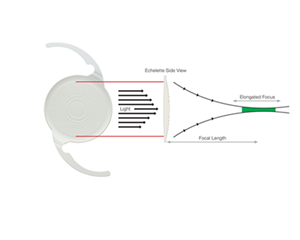 EDOF IOLs represent a new IOL technology that has recently emerged for the treatment of presbyopia at the time of cataract surgery. In contrast to multifocal IOLs, EDOF IOLs seem to work by creating a single elongated focal point inside the eye rather than two distinct focal points like multifocal IOLs. The objective of the EDOF IOL is too give increased range of vision without sacrificing distance visual acuity resulting in what is known as enhanced “depth of focus”.
EDOF IOLs represent a new IOL technology that has recently emerged for the treatment of presbyopia at the time of cataract surgery. In contrast to multifocal IOLs, EDOF IOLs seem to work by creating a single elongated focal point inside the eye rather than two distinct focal points like multifocal IOLs. The objective of the EDOF IOL is too give increased range of vision without sacrificing distance visual acuity resulting in what is known as enhanced “depth of focus”.
These lenses are ideal for patients seeking high quality intermediate range and distance range vision. Though near range vision is possible, multifocal IOLs are often better at giving high acuity near range vision when compared to EDOF IOLs. Like Multifocal IOLs, EDOF lenses do show a slight decrease in contrast when compared to Monofocal IOLs, but EDOF IOL companies tout better contrast sensitivity and less visual disturbances than traditional multifocal IOLs. One unique visual phenomenon that can be associated with EDOF IOLs are “starbursts” or points of light radiating from car headlights.
In general, the benefit of EDOF IOLs are that they can offer a range of vision which is best for patients seeking good intermediate and distant range vision independent of glasses. Visual phenomenon similar to that of multifocals IOLs can be reported such as glare and starbursts around car headlights as well as decreased contrast sensitivity in low light conditions, but these phenomenon may be reported at similar rates or less than with traditional multifocal IOLs.
At Advanced Eye Institute, when placing EDOF IOLs we recommend Laser cataract surgery to assist in the centration of the IOL. EDOF IOLs must be well centered to perform as they are intended. We also use the ORA system to double check lens power calculations to make sure the best power lens is selected for optimal result.
Trifocal IOLs
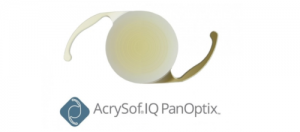 Trifocal technology is now available in the U.S. in the form of the Alcon Panoptix Trifocal IOL. Trifocal technology has been a popular lens replacement option for many areas outside the U.S for some time now. Trifocal IOLs provide for distance, intermediate, and near focal ranges and are another great option for patients seeking a wide range of vision with emphasis on intermediate and distance ranges. This type of IOL technology is the latest to be FDA approved in the U.S. and many U.S surgeons are just beginning to utilize them into practice.
Trifocal technology is now available in the U.S. in the form of the Alcon Panoptix Trifocal IOL. Trifocal technology has been a popular lens replacement option for many areas outside the U.S for some time now. Trifocal IOLs provide for distance, intermediate, and near focal ranges and are another great option for patients seeking a wide range of vision with emphasis on intermediate and distance ranges. This type of IOL technology is the latest to be FDA approved in the U.S. and many U.S surgeons are just beginning to utilize them into practice.
The benefits of trifocal IOLs are that they can offer a complete range of vision, and though multifocal IOLs may outperform them at near range, Trifocal IOLs can offer superior intermediate range vision in comparison to multifocal IOLs while possibly edging out the EDOF IOLs at near range performance. They represent a good compromise for all ranges of vision for patients with active lifestyles who are not avid readers and do not have specific need for high performance near range vision.
At Advanced Eye Institute, when placing these IOLs , we recommend Laser cataract surgery to assist in the centration of the IOL. Trifocal IOLs must be well centered to perform as they are intended. We also use the ORA system to double check lens power calculations to make sure the best power lens is selected for optimal result.
Toric Multifocal/EDOF/Trifocal IOLs
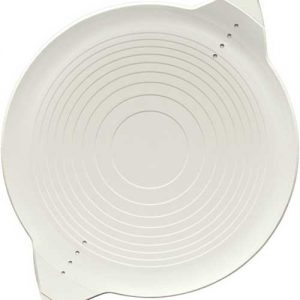 It should be noted that all of the previously described presbyopia correcting ATIOLs are now available on Toric platforms so that they can be used to correct both presbyopia and mild to moderate amounts of astigmatism. In general as long as these AT IOLs are able to adequately neutralize the corneal astigmatism their vision range profiles will remain intact as previously described. There is a bit of added complexity in the implantation process as the IOLs must be aligned to the appropriate meridian of maximal astigmatism, and then the IOL must be well centered in the visual axis. Overall, they provide an excellent option for those seeking correction for both mild to moderate astigmatism and presbyopia.
It should be noted that all of the previously described presbyopia correcting ATIOLs are now available on Toric platforms so that they can be used to correct both presbyopia and mild to moderate amounts of astigmatism. In general as long as these AT IOLs are able to adequately neutralize the corneal astigmatism their vision range profiles will remain intact as previously described. There is a bit of added complexity in the implantation process as the IOLs must be aligned to the appropriate meridian of maximal astigmatism, and then the IOL must be well centered in the visual axis. Overall, they provide an excellent option for those seeking correction for both mild to moderate astigmatism and presbyopia.
At Advanced Eye Institute, when placing these IOLs we recommend Laser cataract surgery to assist in the centration of the IOL. Multifocal IOLs must be well centered to perform as they are intended. We also use the ORA system to double check lens power calculations to make sure the best power lens is selected for optimal result.
Experience You Can See
Thibodaux : 985-446-0506 | Houma : 985-879-2393
